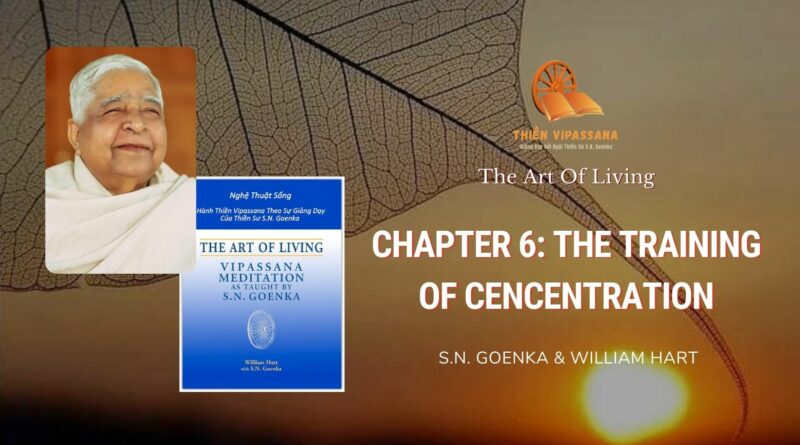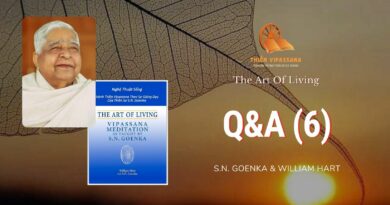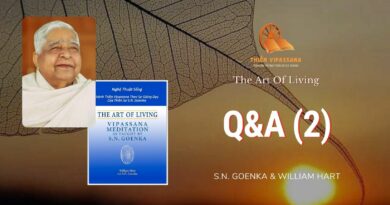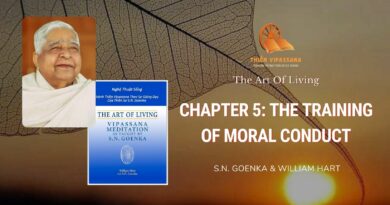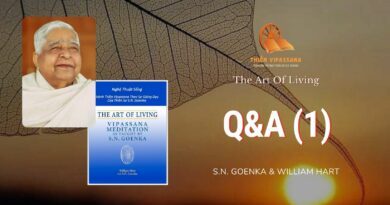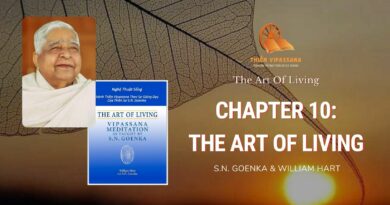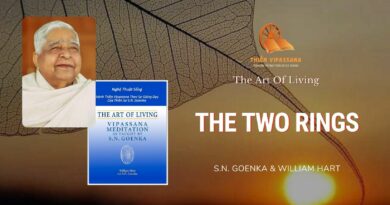Chapter 6. THE TRAINING OF CONCENTRATION
By practising sīla we attempt to control our speech and physical actions. However, the cause of suffering lies in our mental actions. Merely restraining our words and deeds is useless if the mind continues to boil in craving and aversion, in unwholesome mental actions. Divided against ourselves in this way, we can never be happy. Sooner or later the craving and aversion will erupt and we shall break sīla, harming others and ourselves.
Intellectually one may understand that it is wrong to commit unwholesome actions. After all, for thousands of years every religion has preached the importance of morality. But when the temptation comes, it overpowers the mind and one breaks sīla. An alcoholic may know perfectly well that he should not drink because alcohol is harmful to him, and yet when the craving arises he reaches for the alcohol and becomes intoxicated. He cannot stop himself, because he has no control over his mind. But when one learns to cease committing unwholesome mental actions, it becomes easy to refrain from unwholesome words and deeds.
Because the problem originates in the mind, we must confront it at the mental level. In order to do so, we must undertake the practice of bhāvanā—literally, “mental development,” or in common language, meditation. Since the time of the Buddha, the meaning of the word bhāvanā has become vague as the practice of it has fallen away. In recent times, it has been used to refer to any sort of mental culture or spiritual uplift, even such activities as reading, talking, hearing, or thinking about Dhamma. “Meditation,” the most common English translation of bhāvanā, is used even more loosely to refer to many activities, from mental relaxation, day-dreaming, and free association, to self-hypnosis. All these are far from what the Buddha meant by bhāvanā. He used the term to refer to specific mental exercises, precise techniques for focusing and purifying the mind.
Bhāvanā includes the two trainings of concentration (samādhi) and wisdom (paññā). The practice of concentration is also called “the development of tranquility” (samatha-bhāvanā), and that of wisdom is called “the development of insight” (vipassanā-bhāvanā). The practice of bhāvanā begins with concentration, which is the second division of the Noble Eightfold Path. This is the wholesome action of learning to take control of the mental processes, to become master of one’s own mind. Three parts of the path fall within this training: right effort, right awareness, and right concentration.
Right Effort
Right effort is the first step in the practice of bhāvanā. The mind is easily overcome by ignorance, easily swayed by craving or aversion. Somehow we must strengthen it so that it becomes firm and stable, a useful tool for examining our nature at the subtlest level in order to reveal and then remove our conditioning.
A doctor, wishing to diagnose the disease of a patient, will take a blood sample and place it under a microscope. Before examining the sample, the doctor must first focus the microscope properly, and fix it in focus. Only then is it possible to inspect the sample, discover the cause of the disease and determine the proper treatment to cure the disease. Similarly, we must learn to focus the mind, to fix and maintain it on a single object of attention. In this way we make it an instrument for examining the subtlest reality of ourselves.
The Buddha prescribed various techniques for concentrating the mind, each suited to the particular person who came to him for training. The most suitable technique for exploring inner reality, the technique the Buddha himself practised, is that of ānāpāna-sati, “awareness of respiration.”
Respiration is an object of attention that is readily available to everyone, because we all breathe from the time of birth until the time of death. It is a universally accessible, universally acceptable object of meditation. To begin the practice of bhāvanā, meditators sit down, assume a comfortable, upright posture, and close their eyes. They should be in a quiet room with little to distract the attention. Turning from the outer world to the world within, they find that the most prominent activity is their own breathing; so they give attention to this object: the breath entering and leaving the nostrils.
This is not a breathing exercise; it is an exercise in awareness. The effort is not to control the breath but instead to remain conscious of it as it naturally is: long or short, heavy or light, rough or subtle. For as long as possible one fixes the attention on the breath, without allowing any distractions to break the chain of awareness.
As meditators we find out at once how difficult this is. As soon as we try to keep the mind fixed on respiration, we begin to worry about a pain in the legs. As soon as we try to suppress all distracting thoughts, a thousand things jump into the mind: memories, plans, hopes, fears. One of these catches our attention, and after some time we realize that we have forgotten completely about breathing. We begin again with renewed determination, and again after a short time we realize that the mind has slipped away without our noticing.
Who is in control here? As soon as one begins this exercise, it becomes very clear very quickly that in fact the mind is out of control. Like a spoiled child who reaches for one toy, becomes bored, and reaches for another, and then another, the mind keeps jumping from one thought, one object of attention to another, running away from reality.
This is the ingrained habit of the mind; this is what it has been doing all our lives. But once we start to investigate our true nature, the running away must stop. We must change the mental habit pattern and learn to remain with reality. We begin by trying to fix the attention on the breath. When we notice that it has wandered away, patiently and calmly we bring it back again. We fail and try again, and again. Smilingly, without tension, without discouragement, we keep repeating the exercise. After all, the habit of a lifetime is not changed in a few minutes. The task requires repeated, continuous practice as well as patience and calmness. This is how we develop awareness of reality. This is right effort.
The Buddha described four types of right effort:
- to prevent evil, unwholesome states from arising;
- to abandon them if they should arise;
- to generate wholesome states not yet existing;
- to maintain them without lapse, causing them to develop and to reach full growth and perfection.1
By practising awareness of respiration, we practise all four right efforts. We sit down and fix attention on the breath without any intervening thought. By doing so, we initiate and maintain the wholesome state of self-awareness. We prevent ourselves from falling into distraction, or absent-mindedness, from losing sight of reality. If a thought arises, we do not pursue it, but return our attention once again to the breath. In this way, we develop the ability of the mind to remain focused on a single object and to resist distractions—two essential qualities of concentration.
Right Awareness
Observing respiration is also the means for practising right awareness. Our suffering stems from ignorance. We react because we do not know what we are doing, because we do not know the reality of ourselves. The mind spends most of the time lost in fantasies and illusions, reliving pleasant or unpleasant experiences and anticipating the future with eagerness or fear. While lost in such cravings or aversions we are unaware of what is happening now, what we are doing now. Yet surely this moment, now, is the most important for us. We cannot live in the past; it is gone. Nor can we live in the future; it is forever beyond our grasp. We can live only in the present.
If we are unaware of our present actions, we are condemned to repeating the mistakes of the past and can never succeed in attaining our dreams for the future. But if we can develop the ability to be aware of the present moment, we can use the past as a guide for ordering our actions in the future, so that we may attain our goal.
Dhamma is the path of here-and-now. Therefore we must develop our ability to be aware of the present moment. We require a method to focus our attention on our own reality in this moment. The technique of ānāpāna-sati is such a method. Practising it develops awareness of oneself in the here-and-now: at this moment breathing in, at this moment breathing out. By practising awareness of respiration, we become aware of the present moment.
Another reason for developing awareness of respiration is that we wish to experience ultimate reality. Focusing on breathing can help us explore whatever is unknown about ourselves, to bring into consciousness whatever has been unconscious. It acts as a bridge between the conscious and unconscious mind, because the breath functions both consciously and unconsciously. We can decide to breathe in a particular way, to control the respiration. We can even stop breathing for a time. And yet when we cease trying to control respiration, it continues without any prompting.
For example, we may begin by breathing intentionally, slightly hard, in order to fix the attention more easily. As soon as the awareness of respiration becomes clear and steady, we allow the breath to proceed naturally, either hard or soft, deep or shallow, long or short, fast or slow. We make no effort to regulate the breath; the effort is only to be aware of it. By maintaining awareness of natural breath we have started observing the autonomic functioning of the body, an activity which is usually unconscious. From observing the gross reality of intentional breathing, we have progressed to observing the subtler reality of natural breathing. We have begun to move beyond superficial reality toward awareness of a subtler reality.
Yet another reason for developing awareness of respiration is in order to become free of craving, aversion, and ignorance, by first becoming aware of them. In this task the breath can help, because respiration acts as a reflection of one’s mental state. When the mind is peaceful and calm, the breath is regular and gentle. But whenever negativity arises in the mind, whether anger, hatred, fear, or passion, then respiration becomes more rough, heavy, and rapid. In this way, our respiration alerts us to our mental state and enables us to start to deal with it.
There is yet another reason for practising awareness of breathing. Since our goal is a mind free of negativity, we must be careful that every step we take toward that goal is pure and wholesome. Even in the initial stage of developing samādhi we must use an object of attention which is wholesome. Breath is such an object. We cannot have craving or aversion toward the breath, and it is a reality, totally divorced from illusion or delusion. Therefore it is an appropriate object of attention.
In the moment when the mind is fully focused on respiration, it is free from craving, free of aversion, and free of ignorance. However brief that moment of purity may be, it is very powerful, for it challenges all one’s past conditioning. All the accumulated reactions are stirred up and begin to appear as various difficulties, physical as well as mental, which hinder one’s efforts to develop awareness. We may experience impatience for progress, which is a form of craving; or else aversion may arise in the form of anger and depression because progress seems slow. Sometimes lethargy overwhelms us and we doze off as soon as we sit to meditate. Sometimes we may be so agitated that we fidget or find excuses to avoid meditating. Sometimes skepticism undermines the will to work—obsessive, unreasoning doubts about the teacher, or the teaching, or our own ability to meditate. When suddenly faced with these difficulties, we may think of giving up the practice altogether.
At such a moment we must understand that these hindrances have arisen only in reaction to our success in practising awareness of respiration. If we persevere they will gradually disappear. When they do, the work becomes easier, because even at this early stage of practice, some layers of conditioning have been eradicated from the surface of the mind. In this way, even as we practise awareness of breathing, we begin to cleanse the mind and advance toward liberation.
Right Concentration
Fixing the attention on respiration develops awareness of the present moment. Maintaining this awareness from moment to moment, for as long as possible, is right concentration.
In the daily actions of ordinary life, concentration is also required, but it is not necessarily the same as right concentration. A person may be concentrating on satisfying a sensual desire or forestalling a fear. A cat waits with all its attention focused on a mousehole, ready to pounce as soon as a mouse appears. A pick-pocket is intent on the victim’s wallet, waiting for the moment to remove it. A child in bed at night stares fearfully at the darkest corner of the room, imagining monsters hidden in the shadows.
None of these is right concentration, concentration that can be used for liberation. Samādhi must have as its focus an object that is free from all craving, all aversion, all illusion.
In practising awareness of breathing one finds how difficult it is to maintain unbroken awareness. Despite a firm determination to keep the attention fixed on the object of the breath, somehow it slips away unnoticed. We find we are like a drunken man trying to walk a straight line, who keeps straying to one side or the other. In fact we are drunk with our own ignorance and illusions, and so we keep straying into past or future, craving or aversion. We cannot remain on the straight path of sustained awareness.
As meditators, we would be wise not to become depressed or discouraged when faced with these difficulties, but instead to understand that it takes time to change the ingrained mental habits of years. It can be done only by working repeatedly, continuously, patiently, and persistently. Our job is simply to return attention to our breathing as soon as we notice that it has strayed. If we can do that, we have taken an important step toward changing the wandering ways of the mind. And by repeated practice, it becomes possible to bring the attention back more and more quickly. Gradually, the periods of forgetfulness become shorter and the periods of sustained awareness—samādhi—become longer.
As concentration strengthens, we begin to feel relaxed, happy, full of energy. Little by little the breath changes, becoming soft, regular, light, shallow. At times it may seem that respiration has stopped altogether. Actually, as the mind becomes tranquil, the body also becomes calm and the metabolism slows down, so that less oxygen is required.
At this stage some of those who practise awareness of respiration may have various unusual experiences: seeing lights or visions while sitting with eyes closed or hearing extraordinary sounds, for example. All these so-called extrasensory experiences are merely indications that the mind has attained a heightened level of concentration. In themselves these phenomena have no importance and should be given no attention. The object of awareness remains respiration; anything else is a distraction. Nor should one expect such experiences; they occur in some cases and not in others. All these extraordinary experiences are simply milestones that mark progress on the path. Sometimes the milestone may be hidden from view, or we may be so intent on the path that we stride ahead without noticing it. But if we take such a milestone as the final goal and cling to it, we cease making progress altogether. After all, there are countless extraordinary sensory experiences to be had. Those practising Dhamma are not seeking such experiences but rather insight into their own nature, so as to attain freedom from suffering.
Therefore we continue to give attention only to respiration. As the mind becomes more concentrated, the breath becomes finer and more difficult to follow, thereby requiring still greater efforts to remain attentive. In this way we continue to hone the mind, to sharpen the concentration, to make of it a tool with which to penetrate beyond apparent reality in order to observe the subtlest reality within.
There are many other techniques to develop concentration. One may be taught to concentrate on a word by repeating it, or on a visual image, or even to perform over and over again a certain physical action. In doing so one becomes absorbed in the object of attention, and attains a blissful state of trance. Although such a state is no doubt very pleasant so long as it lasts, when it ends one finds oneself back in ordinary life with the same problems as before. These techniques work by developing a layer of peace and joy at the surface of the mind, but in the depths the conditioning remains untouched. The objects used to attain concentration in such techniques have no connection with the moment-to-moment reality of oneself. The bliss that one attains is superimposed, intentionally created, rather than arising spontaneously from the depths of a purified mind. Right samādhi cannot be spiritual intoxication. It must be free from all artificiality, all illusions.
Even within the teaching of the Buddha, there are various states of trance—jhāna—that can be attained. The Buddha himself was taught eight states of mental absorption before he became enlightened, and he continued to practise them throughout his life. However, states of trance alone could not liberate him. When he taught the states of absorption, therefore, he emphasized their function only as stepping-stones to the development of insight. Meditators develop the faculty of concentration not in order to experience bliss or ecstasy, but rather to forge the mind into an instrument with which to examine their own reality and to remove the conditioning that causes their suffering. This is right concentration.
Source: The Art Of Living book – by S.N. Goenka & William Hart

